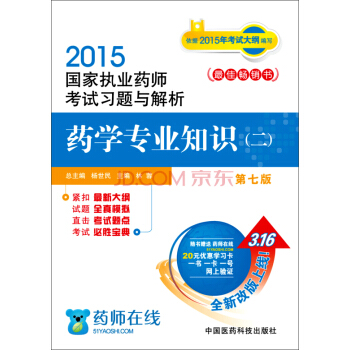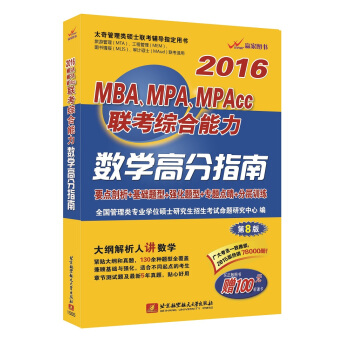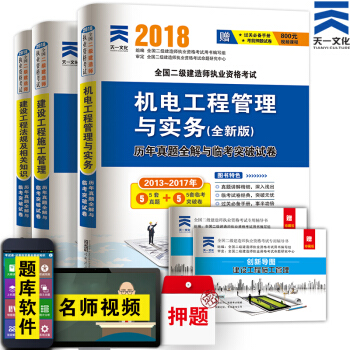具体描述
编辑推荐
《市政公用工程管理与实务·2017全国一级建造师执业资格考试过关必备》一书不仅帮助考生精准掌握考点、全面了解命题思路及考试趋势,而且可提高学习的系统性和完整性。
本书适用于参加全国一级建造师执业资格考试的考生。
内容简介
《市政公用工程管理与实务》一书是《2017全国一级建造师执业资格考试过关必备》系列书之一,按照章节知识模块化、深度解析“市政公用工程管理与实务”科目的历年真题,以真题渗透考点,系统归纳。本书主要内容包括三大模块:通用管理、专业管理和专业技术。
作者简介
《市政公用工程管理与实务·2017全国一级建造师执业资格考试过关必备》一书作者——左红军,建造师建筑名师,执业资格考试命题专家。曾担任8年项目经理和4年项目总监等,有着丰富的现场管理经验;曾同时参加监理、造价、咨询工程师执业资格考试命题、审题、拟定标答工作;2000-2008年16次带队阅卷;理论功底深厚,考点把握精准、模拟题型逼真、应试技巧独特,授课针对性强,命中率极高。
内页插图
目录
通关须知
第一篇 通用管理
第一章 施工招投标管理
第二章 施工合同管理
第三章 工程造价管理
第四章 施工成本管理
第五章 施工进度管理
第二篇 专业管理
第一章 施工组织设计
第二章 施工现场管理
第三章 质量管理
第四章 安全管理
第三篇 专业技术
第一章 城镇道路工程
第二章 城市桥梁工程
第三章 城市轨道交通工程
第四章 给排水场站工程
第五章 城市管道工程
第六章 其他市政工程
前言/序言
《全国一级建造师执业资格考试过关必备》系列丛书共7册,分别为
1.《建设工程经济》(马庆华 邵勇)
2.《建设工程法规及相关知识》(李轻舟)
3.《建设工程项目管理》(叶宏)
4.《建筑工程管理与实务》(左红军)
5.《机电工程管理与实务》(唐琼)
6.《市政公用工程管理与实务》(左红军)
7.《市政公用工程管理与实务百题讲坛》(胡宗强)
本系列书深度解析了各科目的历年真题及经典题,不仅帮助考生掌握考点、全面了解命题思路及考试趋势,而且提高了学习的系统性和完整性,从而拟订可行的复习计划。
“建设工程经济”“建设工程法规及相关知识”和“建设工程项目管理”3门公共基础课全部为客观题,“工程管理与实务”由客观题和主观题组成。
本套系列书主要内容包括:应试技巧指导、近年全国一级建造师执业资格考试真题解析、经典题解析或考点拾遗,并配有二维码,承载图片、视频、拓展知识点,立体直观、全面解读。“市政实务专业”提供2本书:《市政公用工程管理与实务》按照章节顺序系统梳理知识点及配备相应真题,并严格按照最新的法律、法规、部门规章和标准规范解读真题;《市政公用工程管理与实务百题讲坛》针对100道经典案例真题进行集中剖析,直击得分关键,在真题的基础上训练和揣摩命题考核点,使得考生的备考事半功倍。
本书的作者均为在教学一线工作多年的权威、资深专家,对考试情况和考生学习都十分了解,解析内容反复推敲,力争精练准确。
在《2017全国一级建造师执业资格考试过关必备》系列书编写过程中,虽经反复推敲核正,仍不免有疏漏和不妥之处,恳请广大读者提出宝贵意见。
municipal public works management and practice. 2017 National First-Level Constructor Qualification Examination Pass Essentials. Title: A Comprehensive Guide to Modern Urban Infrastructure Development and Management Introduction: Urban infrastructure is the backbone of any thriving metropolis, serving as the silent orchestrator of daily life, economic activity, and societal progress. From the intricate network of water supply and drainage systems that quench the thirst of millions to the robust transportation arteries that connect communities and facilitate commerce, these essential services underpin our quality of life and the very functionality of our cities. The dynamic nature of urban development, coupled with evolving technological advancements and increasing environmental consciousness, presents both formidable challenges and exciting opportunities in the realm of municipal public works. This book delves into the multifaceted world of modern urban infrastructure, offering a comprehensive exploration of its planning, design, construction, operation, and maintenance. It is meticulously crafted for professionals, students, and policymakers seeking a deeper understanding of the principles, practices, and future trajectories of this critical sector. Chapter 1: The Evolving Landscape of Urban Infrastructure This chapter sets the stage by examining the historical evolution of municipal public works, tracing their development from rudimentary systems to the complex, interconnected networks we rely on today. We will explore the socio-economic drivers that have shaped infrastructure growth, including industrialization, population expansion, and urbanization. Furthermore, this section will critically analyze the contemporary challenges facing urban infrastructure, such as aging assets, increasing demand, climate change impacts, and the need for sustainable development. We will also discuss the paradigm shift towards smart cities and the role of technology in enhancing the efficiency, resilience, and sustainability of municipal services. Key themes will include the interconnectedness of various infrastructure systems, the concept of integrated urban planning, and the importance of a long-term perspective in infrastructure investment. Chapter 2: Principles of Urban Planning and Infrastructure Development Effective urban infrastructure development is intrinsically linked to sound urban planning. This chapter provides a thorough overview of the fundamental principles of urban planning, emphasizing how they inform and guide the strategic placement, scale, and integration of various public works. We will discuss different urban planning methodologies, including land-use planning, transportation planning, and environmental planning, and their symbiotic relationship with infrastructure. The chapter will delve into the process of needs assessment, demand forecasting, and the establishment of long-term infrastructure master plans. Furthermore, we will explore the critical aspects of site selection, environmental impact assessment, and the integration of green infrastructure principles from the outset of planning. The importance of public engagement and stakeholder participation in the planning process will also be highlighted. Chapter 3: Water Supply and Wastewater Management Systems Water, the essence of life, is a cornerstone of municipal public works. This chapter offers an in-depth examination of modern water supply systems, covering source water protection, water treatment processes, disinfection techniques, and the design and operation of distribution networks. We will explore advanced water management strategies, including water conservation measures, rainwater harvesting, and the reuse of treated wastewater. Concurrently, the chapter will address the critical importance of effective wastewater management, detailing the design and operation of sewerage systems, wastewater treatment plants, and sludge management. Emerging technologies in wastewater treatment, such as membrane filtration and nutrient removal, will be discussed, alongside the challenges of industrial wastewater discharge and the protection of receiving water bodies. The principles of integrated water resource management will be a central theme. Chapter 4: Transportation Infrastructure: Roads, Bridges, and Public Transit The seamless flow of people and goods is vital for urban vitality. This chapter focuses on the planning, design, construction, and maintenance of essential transportation infrastructure. We will analyze the principles of road network design, including highway engineering, street design, and intersection optimization. The chapter will cover the structural aspects of bridges and tunnels, discussing materials, design considerations, and construction techniques. A significant portion will be dedicated to the development and operation of public transportation systems, including bus networks, rail systems, and emerging mobility solutions. The integration of active transportation modes, such as cycling and walking infrastructure, will also be explored, emphasizing the promotion of sustainable and multimodal transportation. The chapter will also touch upon intelligent transportation systems (ITS) and their role in improving traffic management and safety. Chapter 5: Energy Infrastructure: Power Grids and Renewable Energy Integration Reliable and sustainable energy is fundamental to urban functioning. This chapter examines the complex world of energy infrastructure, focusing on the design and operation of power generation, transmission, and distribution systems. We will discuss the challenges associated with maintaining grid stability, managing peak loads, and ensuring energy security. A significant emphasis will be placed on the growing importance of renewable energy sources, such as solar, wind, and geothermal energy, and their integration into existing power grids. The chapter will explore smart grid technologies, energy storage solutions, and the role of distributed energy resources in enhancing grid resilience and reducing carbon emissions. Policy frameworks and economic considerations related to energy infrastructure development will also be addressed. Chapter 6: Solid Waste Management and Resource Recovery The efficient and environmentally sound management of solid waste is a growing concern for urban areas. This chapter provides a comprehensive overview of modern solid waste management strategies, encompassing waste collection, transportation, and disposal. We will explore various disposal methods, including sanitary landfills and waste-to-energy facilities, critically assessing their environmental impacts and economic viability. The chapter will delve into the principles of waste reduction, reuse, and recycling, highlighting the importance of source separation and the development of robust recycling programs. Emerging trends in organic waste management, such as composting and anaerobic digestion, will also be discussed. The chapter will emphasize the concept of a circular economy and the transition towards a zero-waste society. Chapter 7: Telecommunications and Digital Infrastructure In the digital age, robust telecommunications and digital infrastructure are as crucial as traditional utilities. This chapter explores the planning, deployment, and maintenance of these vital networks. We will discuss the evolution of telecommunications technologies, from traditional copper networks to fiber optics and the fifth generation (5G) of wireless technology. The chapter will cover the infrastructure requirements for broadband internet access, mobile communications, and the Internet of Things (IoT). The integration of digital infrastructure with other municipal services to create smart city functionalities will be a key focus. Cybersecurity considerations and data management in the context of urban digital infrastructure will also be addressed. Chapter 8: Green Infrastructure and Sustainable Urban Development This chapter champions the integration of natural systems and processes into urban design and management to create more resilient, sustainable, and livable cities. We will define and explore various forms of green infrastructure, including green roofs, permeable pavements, urban forests, wetlands, and bioswales. The chapter will detail the multiple benefits of green infrastructure, such as stormwater management, air quality improvement, urban heat island mitigation, biodiversity enhancement, and the promotion of public health and well-being. We will also discuss the planning, design, implementation, and maintenance of green infrastructure projects, as well as policy and financing mechanisms that support their widespread adoption. The chapter will emphasize the role of green infrastructure in climate change adaptation and resilience building. Chapter 9: Construction and Project Management in Municipal Public Works The successful realization of municipal public works projects hinges on effective construction and project management. This chapter delves into the principles and practices of managing complex infrastructure projects from conception to completion. We will cover project planning, scheduling, budgeting, risk management, and quality control. The chapter will explore various construction methodologies, contract management, procurement strategies, and the importance of safety management on construction sites. We will also discuss the role of technology, such as Building Information Modeling (BIM), in enhancing project efficiency and collaboration. Ethical considerations and the importance of transparent project governance will be emphasized. Chapter 10: Operation, Maintenance, and Asset Management The long-term functionality and serviceability of municipal public works depend on robust operation, maintenance, and asset management strategies. This chapter addresses the critical aspects of keeping infrastructure systems running efficiently and effectively. We will explore various maintenance approaches, including preventive maintenance, predictive maintenance, and reactive maintenance, and their respective advantages and disadvantages. The chapter will introduce the principles of asset management, focusing on lifecycle costing, performance monitoring, and the strategic renewal and replacement of infrastructure assets. The role of data analytics and digital tools in optimizing operations and maintenance will be highlighted, along with the importance of skilled personnel and effective workforce management. Chapter 11: Regulatory Frameworks, Policy, and Governance Municipal public works operate within a complex web of regulations, policies, and governance structures. This chapter provides an overview of the legal and institutional frameworks that govern infrastructure development and management. We will examine national, regional, and local regulations related to environmental protection, public health and safety, land use, and construction standards. The chapter will discuss the roles and responsibilities of various government agencies, utility providers, and regulatory bodies. We will also explore different models of public-private partnerships (PPPs), financing mechanisms for infrastructure projects, and the importance of effective governance, transparency, and accountability in ensuring public trust and achieving sustainable development goals. Chapter 12: Future Trends and Innovations in Municipal Public Works The field of municipal public works is constantly evolving, driven by technological advancements, societal demands, and global challenges. This concluding chapter looks towards the future, exploring emerging trends and innovations that will shape the next generation of urban infrastructure. We will discuss the impact of artificial intelligence (AI) and machine learning on infrastructure management, the growing role of the Internet of Things (IoT) in creating smart and responsive systems, and advancements in materials science for more durable and sustainable infrastructure. The chapter will also address the critical need for increased resilience to climate change impacts, the development of circular economy models in infrastructure, and the evolving expectations of citizens for more efficient, equitable, and environmentally responsible public services. The chapter will inspire readers to embrace innovation and contribute to building smarter, more sustainable, and resilient cities for the future.






















